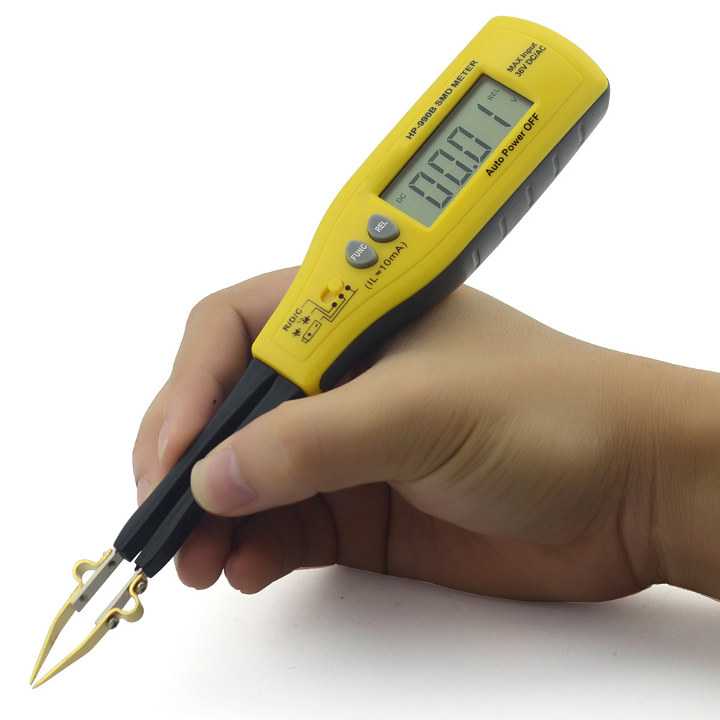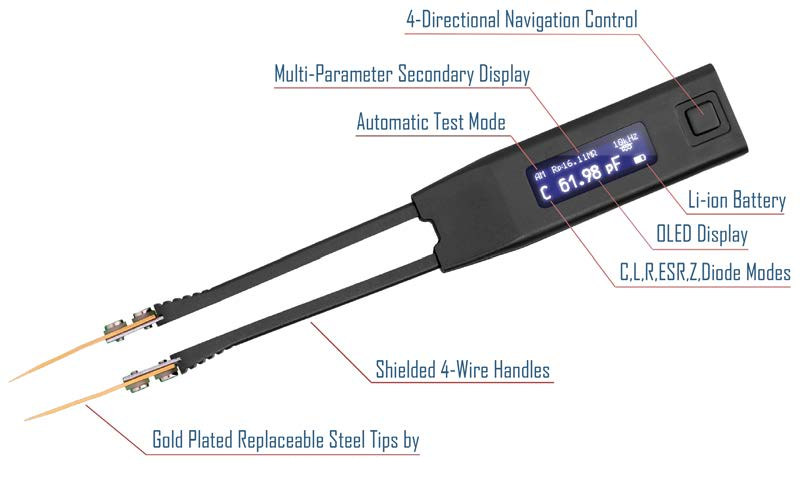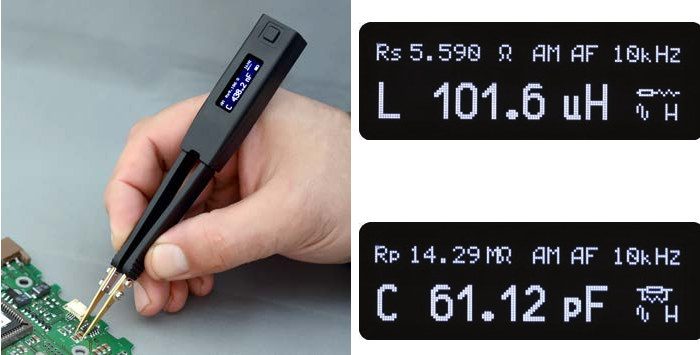Soldering SMD components normally require a pair of tweezers, and since those components are so small it may be hard to read the value on them if any. That means if you’d like to double-check the value of an SMD component you may have to use a multimeter first, before placing it on the board and solder it.
There’s a better way: Ideal-Tek Smart Tweezers Colibri ST-5S with a built-in LCR meter that can help you automatically identify SMD components and read their values in a convenient tweezers form factor.
Smart Tweezers Colibri ST-5S key features & specifications:
- Built-in high-precision LCR probe
- Display – OLED Display
- Ranges
- Resistance (R) – 0.05 Ohm to 9.9 MOhm
- Capacitance (C) – 0.5 pF to 4999 uF
- Inductance (L) – 0.5 uH to 999 mH
- Quality Factor (Q) – 0.001 to 1,000
- Dissipation Factor (D) – 0.001 to 1,000
- AC test mode Test frequency – 1 kHz, 10 kHz, 120 Hz, 100 Hz; accuracy: 50 PPM (0.005%)
- Test signal levels – 0.25-1.0 Vrms
- Source Impedance – 100 Ohms
- Diode Polarity/Short Testing
- Equivalent Series Resistance testing
- Misc – 4-directional joystick-like navigation control
- Battery – 180mAh/3.7V LiPo battery good for 20 hours; 3 hours charging cycle
- Power Supply – Micro USB port
- Dimensions – 15 x 1.8 x 1.5 cm
- Weight – 29 grams
The kit includes the smart tweezers, a NIST-traceable calibration certificate, straight test leads (installed), Ideal-Tek spare test leads, clamshell carrying case, a pocket hard case, a universal 110-240V wall charger, and Micro USB cable for charging from a USB port. The tool is suitable for either right or left-handed uses since the display can rotate accordingly.
The Smart Tweezers are sold on Saelig for $299.00, and various tips are available as shown in the datasheet. $300 is fine for professionals, but out of the budget of most makers, so I went on a little search on Aliexpress, and HP-990B low-cost smart tweezers sell for $15 and up. Don’t expect the accuracy and features of Ideal-Tek model, but it supports capacitance and resistance, as well as diode testing.

Via Altium

Jean-Luc started CNX Software in 2010 as a part-time endeavor, before quitting his job as a software engineering manager, and starting to write daily news, and reviews full time later in 2011.
Support CNX Software! Donate via cryptocurrencies, become a Patron on Patreon, or purchase goods on Amazon or Aliexpress







Thanks for the links, Jean-Luc! These could indeed be very useful. I got a bit cold-showered by the first one’s price, but I’ll have a look at alternatives like the one you pointed. I already have a twizzers-like clamp with two wires for use with a multi-meter but I almost never use it, it’s not really convenient.
Ya well thats how trends begin. Eventually the cold shower becomes a warm one. (Cross ur fingers)
Its how it is. Next gen of nerd brats be spoiled by advanced tools but screwed by finance and ecology.
Just a heads-up, the Colibri version is actually the “ST-5C Colibri”… versus the “ST-5S”, which is their more capable one. I also have it from the manufacturer that the Colibri one will probably be discontinued soon, so the ST-5S is the more recommended version. There is also a comparison page, if you google “smart tweezers colibri comparison”
Also, I actually have a predecessor to these units (which was actually sold, branded by Excelta), and have to say that while it is a very niche product, it does a really good job. If it were just me being a hobbyist though, I don’t know that I’d spend their retail price unless I really was doing a lot of that sort of work. Sorting, along with checking components both in and out of circuit when repairing things is where I use it the most. It is quite accurate, though some of the features are a bit gimmicky in my opinion. My biggest complaint is just how expensive replacement tips are!
Noted. I used Colibri ST-5S because that’s the name in the datasheet I linked at the end of the post.
So the models may be Colibri ST-5S and Colibri ST-5C, with the latter called “Colibri” in the comparision page.